#Florentine Codex
Explore tagged Tumblr posts
Text
The Florentine Codex is the first Indigenous encyclopedia of the New World, a manuscript that documents the culture, politics, natural science, and history of the Mexica (Aztec).
After seven years, with contributions from specialists from around the world, the Digital Florentine Codex is now available. This new tool unlocks a wealth of Mexica history and culture with new translations and features.
Start exploring:
456 notes
·
View notes
Text
Stunning Codex Documenting Aztec Culture Now Fully Digitized The 16th-century “Florentine Codex” offers a Mexican Indigenous perspective that is often missing from historical accounts of the period.
{read}
#tiktok#article#Florentine Codex#16th century#nahuatl#aztec#hyperallergic#colonialism#colonization#genocide#spain#digital archives#art#art history#language#spanish conquest#indigenous#mexico#history
289 notes
·
View notes
Text
For Butterfly Education & Awareness Day:
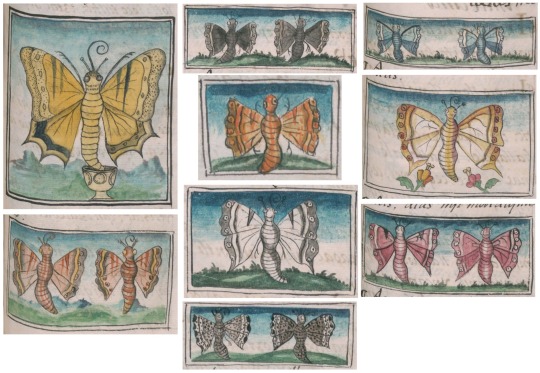
Composite image collecting the illustrations of papalotl (butterflies) in Book 11 of the Florentine Codex ("Earthly Things," the volume dedicated primarily to Aztec natural history). All illustrations were done by Indigenous Nahua artists; the 12-volume encyclopedia was compiled by Spanish Franciscan friar Bernardino de Sahagún and completed c. 1577.
See in the images embedded in the original text here: https://www.loc.gov/resource/gdcwdl.wdl_10622/?sp=6&st=gallery
#animals in art#indigenous art#Mesoamerican art#Florentine Codex#colonial art#16th century art#illustration#codex#illuminated manuscript#book art#butterfly#butterflies#insects#natural history art#Aztec art#Nahua art#Bernardino de Sahagún#Butterfly Education and Awareness Day#Butterfly Day#animal holiday
64 notes
·
View notes
Text

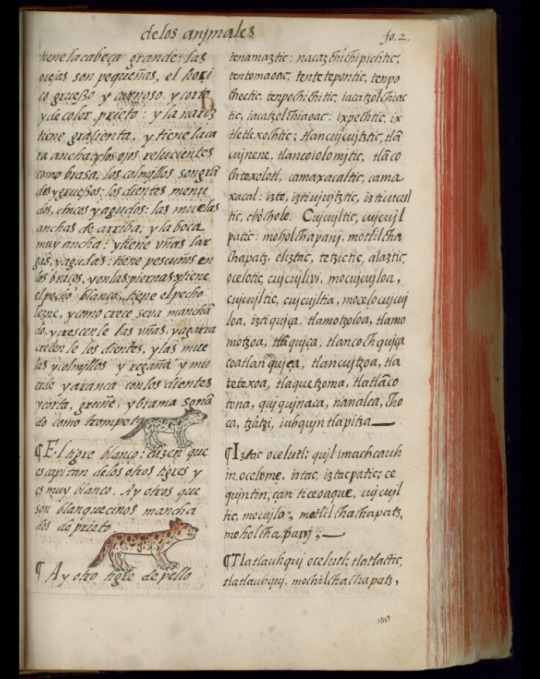
''The Digital Florentine Codex gives access to a singular manuscript created by Franciscan friar Bernardino de Sahagún and a group of Nahua elders, authors, and artists. Written in parallel columns of Nahuatl and Spanish texts and hand painted with nearly 2,500 images, the encyclopedic codex is widely regarded as the most reliable source of information about Mexica culture, the Aztec Empire, and the conquest of Mexico. Upon completion in 1577 at the Imperial Colegio de la Santa Cruz in Tlatelolco (today Mexico City), the manuscript was sent to Europe where it entered the Medici family’s library in Florence—thus, the Florentine Codex.''
''Libro undécimo, de las propriedades de los animales, aves, peces, árboles, yerbas, flores, metales y piedras, y de las colores
Capítulo I, de los animales Párrafo primero, de las bestias fieras
El tigre anda y vive en las sierras y entre las peñas y riscos, y también en el agua. Es noble, y dicen es príncipe y señor de los otros animales. Y es avisado y recatado, y regálase como el gato, y no consiente trabajo ninguno. Y tiene asco de ver cosas sucias y hediondas, y tiénese en mucho. Es baxo y corpulento, y tiene la cola larga, y las manos son gruesas y anchas, y tiene el pescuezo grueso. (...)''
© Getty Research Institute - Digital Florentine Codex
#book#mexico#history#florentine codex#art#drawing#nahuatl#spanish#español#digital resources#the getty museum
13 notes
·
View notes
Text

In his work, the ‘Florentine Codex’ Bernardino de Sahagun, a Spanish scholar and member of the Franciscan order of Friars, describes the happenings and functions of the Aztec trade system and market. Bernardino de Sahagun had learned the local language, Nahuatl as he was a proficient linguist. His intent was to document as many aspects as possible of indigenous lifestyles in South America during the colonisation of the continent, Christianisation of the local population and establishment of Spanish rule. These records were mostly ignored and only published after Sahagun’s death.
In this analysis, we will be looking at a specific excerpt from the manuscript that discusses and documents the trade customs and regulations of the Aztec peoples. According to the text, strict restrictions on what and when certain goods could be traded were the norm. During the reign of the first ruler, Cuacuauhpitzahuac, under whom trade and commerce in this region allegedly began, only a sole three items were allowed to be traded at the market. Subsequent rulers had their own rulesets, so to speak, regarding who was allowed to trade what. Each ruler appointed specific merchants to carry out their trade regulations.8 In the beginning, as only some scarce materials were traded, so the spread of any visual culture or artwork was minimal at best, as trade was not a vessel that encouraged it. Under later rulers however, a greater variety of goods allowed to be traded, eventually including clothes and jewelry. Some later rulers administrated and facilitated the import of wares such as elaborate ear adornments, rings, and necklaces as well as luxury cloths, animal pelts and skins as well as high quality woven products. As time went on, the volume of the goods traded increased as well. The import of this jewellery and clothing is evidence for global connections and exchange of ideas through the medium of art. As a likely result of this increased trade, the possibility of visual ideas being exchanged increases drastically.
As for the bias portrayed by the author, many things can be said. For one, this text features a common attribute that many similar European texts from this time period have: an ethnographic gap. The author, being a Spanish religious official, has no connection to the people he is writing about, apart from the colonial lens he is using to portray and document the Aztec peoples. Sahagun’s position as an outsider also comes with the possibility that his claims are not accurate or represent the reality of the trade networks that existed in the region he discusses in his manuscript. The language he uses to describe the local population contains a lot of value judgements, decreasing the objectivity of his claims. Despite these biases and possible counter claims, the fact that this information was documented in writing, helps preserve evidence of trade networks and creative idea exchange in South American indigenous populations before Spanish colonisation, and cementing this text’s significance for global history.
0 notes
Text
I'm going to be not normal about huitzilopotchli on the not being normal about things website
because he was BORN to protect his mother from his own sister. his birth is an act of protection, and he fails to save BOTH of them, his mother becoming a two-headed snake monster, his sister leading an army against him, made of his own brothers and sisters. when he has to kill them all, they become the stars in the sky, and his sister the moon, and every night he has to fight their angry, dead bodies through the night sky, led by a dog he doesn't know is the closest thing he has anymore to a brother. and one day he will fail and the world knows he's going to lose this fight one day and when it does they will all die and he just has to live with that. they have to love him anyway, give their own flesh and blood anyway
like he leads the people of mexico to lake texcoco. he clearly loves the people. not as much as quetzalcoatl but he does
like who's gonna write the book??? do i have to do it??? will it be me????
#aztec gods#aztec mythology#huitzilopochtli#mesoamerica#dont make me write it#also read the codex florentine its free#and super cool#i love the mexica
29 notes
·
View notes
Text
You are the substitute, the surrogate of Tloque Nahuaque, the lord of near and far. You are the seat [the throne from which he rules], you are his flute [the mouth from which he speaks], he speaks within you, he makes you his lips, his jaws, his ears ... He also makes you his fangs, his claws, for you are his wild beast, you are his eater of people, you are his judge.
The Florentine Codex
29 notes
·
View notes
Text
Top 5 Tezcatlipoca related drawings in the Florentine Codex
1.

Iconic, it's the Toxcatl Sacrifice and doesn't shy away from the blood. The way its drawn doesn't make it repulsive to me the way a lot of gore is though.
2.

It's him! I'm pretty sure the text above is comparing him to Jupiter, which isn't the worst comparison Tezcatlipoca gets hit with (Jupiter is fine but very much not Tezcatlipoca).
3.
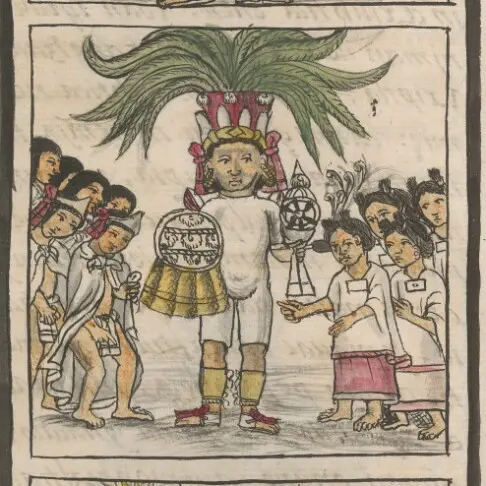
It's him again! Back at Toxcatl to die again. It's definitely not the intention, but to me the face gives off 'I wish I wasn't here right now, not because of the sacrifice but because you're all annoying' vibes, which I find funny.
4.

A prayer to Tezcatlipoca that looks a little silly to me at a glance. "Toot the horn for Tezcatlipoca, now."
5.
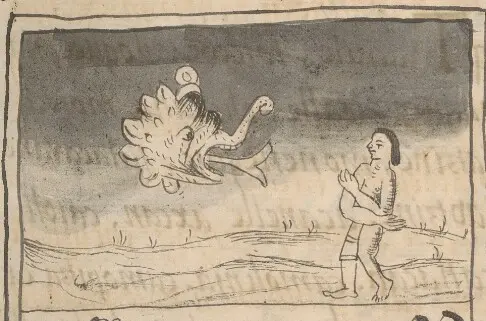
Another prayer to Tezcatlipoca where I can't understand what the hell is going on with it and honestly I'm not sure understanding would change the comedic value for me.
#gore#Tezcatlipoca#aztec mythology#aztec culture#aztec religion#The drawing of the Toxcatl Massacre is the lowest ranked total because I don't like thinking about it#Shout out to the Digital Florentine Codex for being the reason this post exists
29 notes
·
View notes
Text
*emerges from the document dazed and hungry*
Well, I did find what I was looking for, and a whole lot of shit that I wasn't looking for.
#I have a new sub-mission to translate The Florentine Codex into 'common English' because it's so heartwrenchingly beautiful.#There's a real finality and terror to it especially knowing when it was written. That these are the last time anyone will see these things.#The customs are gone. The people are gone. The university is gone. The food is gone. The culture is gone.#And they're described so vividly even when clinical.#Anyway. I found the medicinal texts I was looking for.#ptxt
6 notes
·
View notes
Text
The idea of Olrox being from Cholula specifically makes me so insane. Like would he have identified more as Mexica? Or as Tlaxcaltec? Would he have been loyal to the Tlaxcaltec and allied with the Spanish only to get screwed over like his Mohican lover did in the colonies? Would he have done so thinking he could get the upper hand in the end just like Mizrak/Emmanuel thought the Order could with Erzsebet?
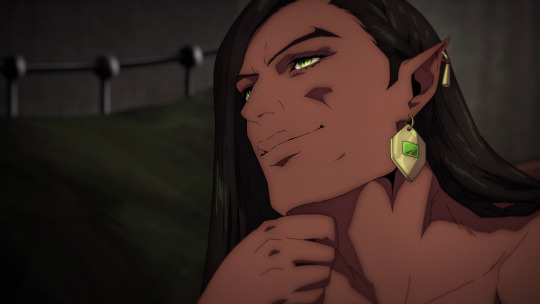
"He thinks the devils he manufactures will be enough to destroy her when the time comes. What do you think? Do you think he's right?" - S1E4
Even after the fall of Tenochtitlan, nobility from all over the region would have been sent to Cholula to get the blessing of Cholulan priests for their legitimacy. How might this have fueled his disdain for nobility?

Olrox: "I prefer my blood blue."
Drolta: "Maybe you do things differently in the new world, but over here we don't feed off the wealthy. The locals will start to grumble." - S1E5
As a Mexica citizen, this disdain could come from resentment toward sumptuary laws, the increasing lack of socioeconomic mobility during Moctezuma's rule, and frustration with how he handled the Spanish... But as a Cholulan sympathetic to Tlaxcala, there's so much more???
It could come from frustration with leadership that defected from the very people who helped them elude Mexica rule in the years before the Spanish conquest. Anger at a decision that economically obliterated the Tlaxcaltec, who became completely surrounded by Mexica member-states? Regret at how much it cost them to 'overthrow' the Mexica? Grief at how this kind of political/military opportunism helped lead the wider indigenous population to its demise?? Like the latter is so much more thematically ripe for a show tackling colonialism and imperialism imo???

"This one? He was just an opportunist, following the Messiah because she's powerful." - S1E4
I mean!!?? Think about how the implications of all of this... *gestures wildly* stuff would lead him to adopt such a cynical, morally ambiguous worldview? This sense that it's all doomed, that he's not strong enough to fight it? Resist and fall to your enemies, or work with them only to lose parts of your identity in the process? Think about how the brutality of the Cholula massacre recontextualizes eurocentric perceptions of the brutality of flower wars and ritual sacrifice??? How it would leave you with anger and pain and an unyielding need for justice?

"Little boy Belmont. I know that feeling. That pain, that hate, that burning, unendurable need for retribution." - S1E1
Think about how the Mexica Empire had adopted Huitzilopochtli (war, sacrifice) as their primary patron deity, and the Tlaxcaltec Mixcoatl/Camaxtli (the hunt, fire)... Yet Olrox's form seems to be based on Quetzalcoatl (wind, knowledge, rebirth, among other things)–the deity the great temple at Cholula was dedicated to.
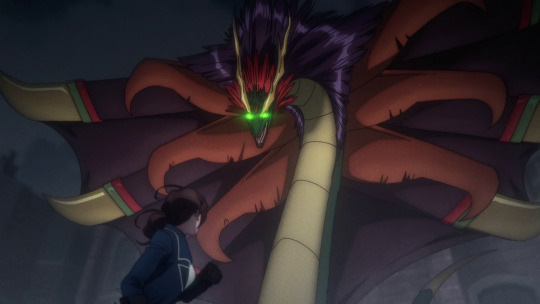
A handful of mesoamerican deities are associated with serpents/have names ending in '-coatl', but Olrox's serpent form clearly has a feathered crest—the 'quetzal-' in Quetzalcoatl.
But Olrox's abilities also seem to include lightning/thunder, which are associated with Tlaloc, who the Cholulans seemed to have adopted as their central deity some time before the Spanish conquest.

Quetzalcoatl is only associated with storms sort of tangentially, through his aspect as the wind god, Ehecatl. The Florentine Codex refers to Quetzalcoatl-Ehecatl as sweeping the roads to make way for the rain and the thunder.
Think about how in Tlaxcaltec accounts, Cholula–being a sacred city–had no real military to speak of and depended on their gods to protect them???

Mizrak: "There's only one God. Just one. That's the only thing I'm sure of. And I've spent my whole life serving him, fighting for him. That hasn't changed, and it never will." Olrox: "One god... And you think he can protect you?" - S1E4
Like... What does it all mean???? 🫠🫠🫠
Agshsjdkdkfll *screams into a pillow* I am so excited for season 2 but whatever happens Cholulan Olrox is canon in my heart y'all
190 notes
·
View notes
Text
Shrike as Huitzilopochtli... 2!
Ah shit. Here we go again. This time with some more facts (and some corrections lol)
Huitzilopochtli, “Hummingbird of the South”, is the patron god of the Mexica (historically called the Aztecs). He was the patron of the capital city of the Aztec empire, Tenochtitlan (now Mexico City). He was the god of warfare and the sun, as the sun of the fifth and current era.
We'll start with the iconography, and then possible themes
—
Huitzi is nearly always represented with quetzal feathers (quetzalli) on his headdress, a lot of gods in the pantheon have them (In my last post I called them hummingbird feathers but those are the ones on his back. Whoops!). These appear in Shrike’s design as the spikes of his tentacles.
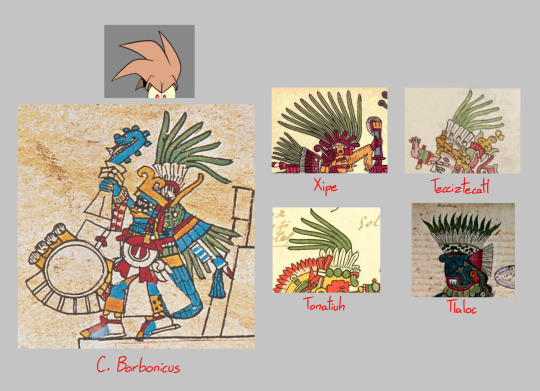
Huitzilopochtli is most known for having a black mask around his eyes. Shrike has dark circles around his eyes. His namesake, shrike, is a bird also known for having a mask of black feathers around its eyes. Additionally, when he’s dressed up as Bandito in ep2, he puts on a dark antiface. And as a potential extra layer, this is to imitate the black masks that raccoons also have.
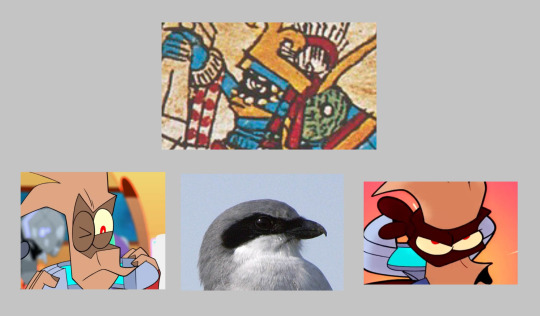
Huitzi is called the "hummingbird of the south", and so he wears the head of a hummingbird on top of his own. The Aztecs also believed that warriors who died in battle got reincarnated into hummingbirds, so that’s another connection to warfare. Shrike has a beak-like mouth that has visibly been getting longer throughout the episodes.
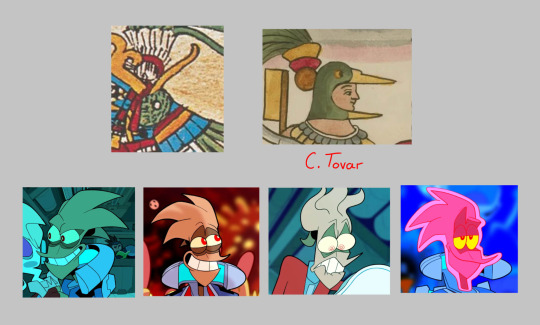
The god has a pectoral circle made of seashell on his chest (anahuatl). I’m not entirely sure if the collar of his jacket is supposed to be a reference to this. In his reference sheet it’s a circle, various animators draw it as a circle, but Zeurel never draws it as a circle when animating, so it might be a stretch.
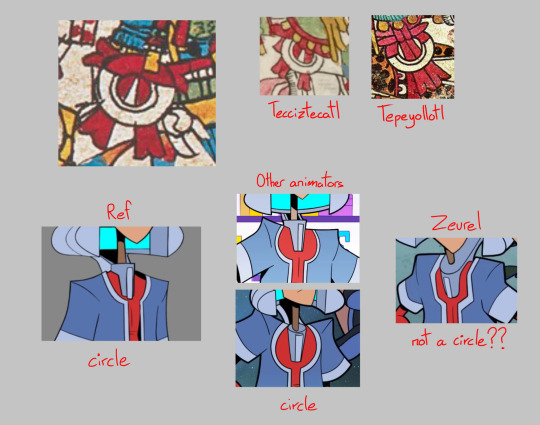
Huitzi commonly carries Xiuhcoatl, the “Turquoise Serpent”, as a weapon, mentioned in the story of his birth in the Florentine Codex. When dressed up as Bandito, Shrike grabs one of the floppy leaves of the plant, resembling the shape of the snake.
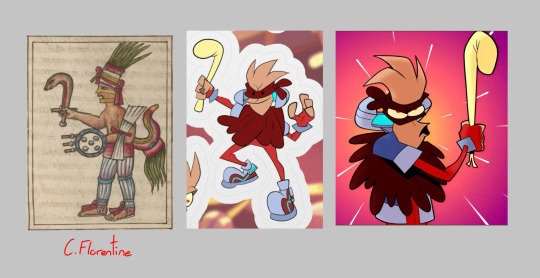
But Xiuhcoatl can also be found on the pattern on the sides of his shoes!
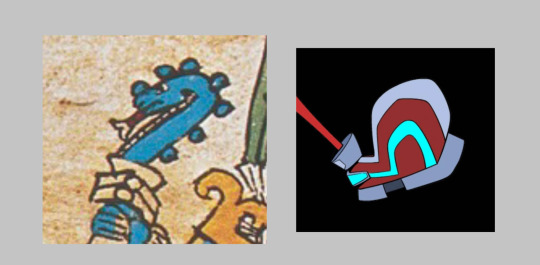
Also mentioned in his origin story in Florentine, he has a xiuh atlatl, a “turquoise dart thrower” (although it can also be associated with Xiuhcoatl as the same thing).
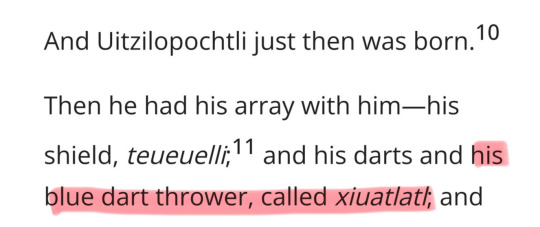
That would be his gun. It’s not the only time that guns are gonna be compared to dart throwers.


—
Huitzilopochtli was the sun of the fifth era to the Mexica. This sun has the symbol “Nahui Ollin”, which means “4 Movement”. The Ollin is one of the Aztec calendar day signs, it means “movement” or “earthquake”, and it is represented as two intertwined lines. Here it is represented in Codex Borgia.
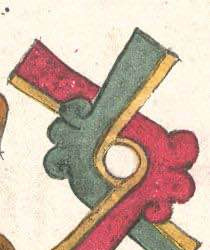
Now here’s what I’m thinking

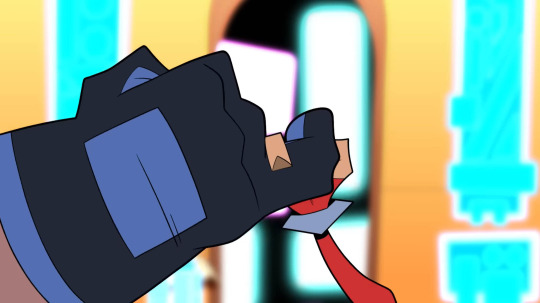
This might just be where Shrike’s pinky quirk comes from! Shrike was the one to tell Beebs about pinky promises, and they seem to be very important to him. So much so that he subconsciously keeps his pinkies up whenever he’s holding his guns or his phone.
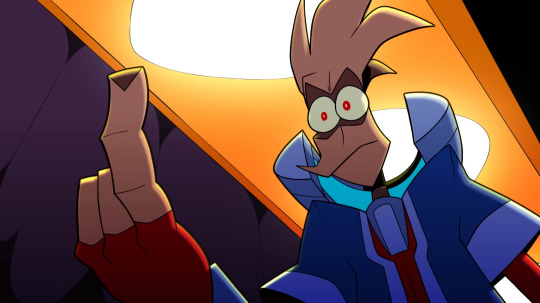


The reason why each era has a name and symbol attributed to it is because they’re named after the way it would end. This fifth era is named after earthquakes because the Aztecs believed that this world would end with strong tremors, the sun would lose its perpetual fight against darkness, and the stars would come down to earth in the form of creatures called Tzitzimime to kill all of humanity.
This god represents the sun. The sun in the solar system. Earth’s sun, our sun, the Terrans’ sun. Yeah, that sun.
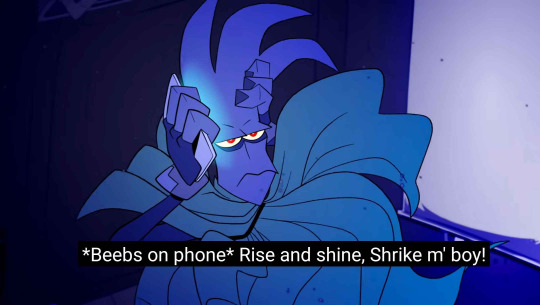

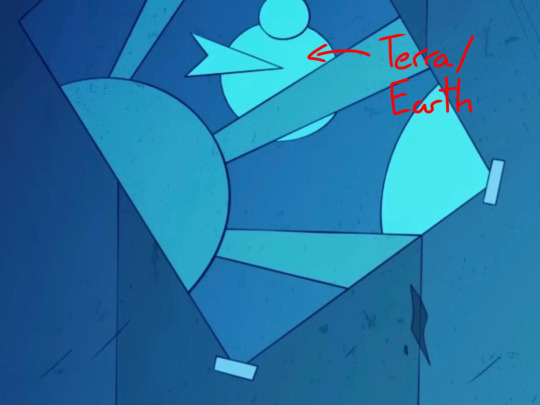
The sun’s job was to illuminate the world for us humans, and to not let it fall into darkness. This could be why Shrike has a fear of the dark, and has such appreciation for Terrans!
Shrike, as the protagonist of the show, is Huitzilopochtli, the god most important to the Mexica. Zeurel currently doesn't have a specific nationality for him, he's generally hispanic, but the crew's Spanish consultant is Mexican, and so is Sr. Pelo, the voice of Bandito. In Bandito's show there are curtains with the colors of the Mexican flag and a prickly pear cactus, which appears in the coat of arms in the middle of said flag.
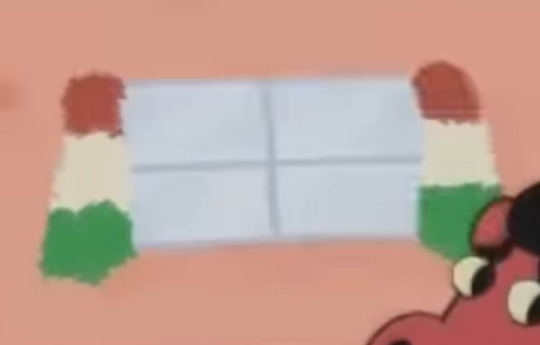

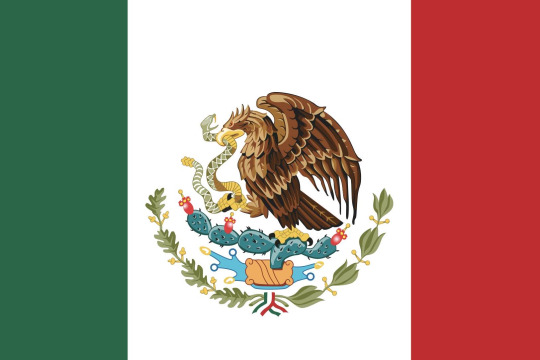
This symbol actually comes from the legend on the origins of Tenochtitlan! Huitzilopochtli told the Mexica to leave Aztlan, the place where they were originally from (that's where the term "Aztec" comes from). He told them to build a new city where they found an eagle perched on a prickly pear cactus, devouring a snake. That was in the middle of lake Texcoco, where Mexico City still stands on today.
I'd say Shrike is the one who has the strongest connection to his past life memories because he feels a strong connection to Mexican culture and language (if he spoke ancient Nahuatl it'd be too obvious so they made him speak Mexican Spanish instead). He also has the habit of calling everyone “amigo”, even to the people he dislikes or doesn’t seem to know at all.
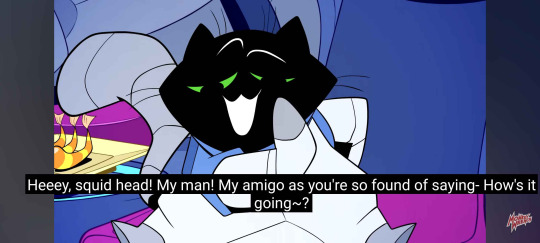
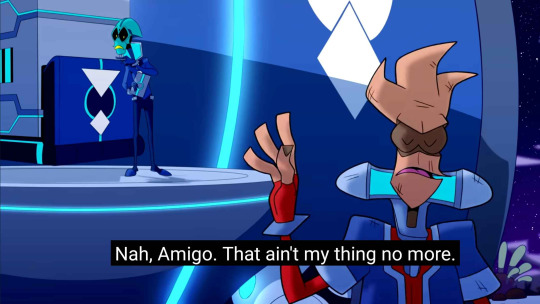
Maybe it’s because he did know them. A long time ago?
List
53 notes
·
View notes
Text

Moon and Sun from the Florentine Codex, 1577
Source
375 notes
·
View notes
Text




Deriving from the Nahuatl word “tamalli,” tamales are a delicious dish made from masa (corn dough) with a variety of fillings. Wrapped in corn husks or banana leaves, they are steamed to perfection.
Featured here are images of tamales and their makers from the Florentine Codex dating back to 16th-century Mexico. The Florentine Codex is the first encyclopedic manuscript of the Américas and documents the culture, politics, natural science, and history of the Mexicas (Aztecs) in parallel columns of Nahuatl and Spanish text and some 2,000 images.
Happy National Tamale Day!
32 notes
·
View notes
Text
So obviously every culture has interesting complex rituals but if the Florentine codex is remotely accurate I think the culture of tenochtitlan like, wins at rituals. They're so elaborate and symbolic and evocative. I should go through Aztecs an intepretation and screenshot my favorites, they're incredible
41 notes
·
View notes
Text

My design for Colotl's cape. The colotilmatli, "scorpion mantle."
It was brought to my attention that Sahagun mentions a "colotilmatli" in the Florentine Codex, but aside from a very small and simple illustration of what look more like ants, there's no faithful depiction of what it could look like. So I designed my own.
61 notes
·
View notes
Text
162 notes
·
View notes